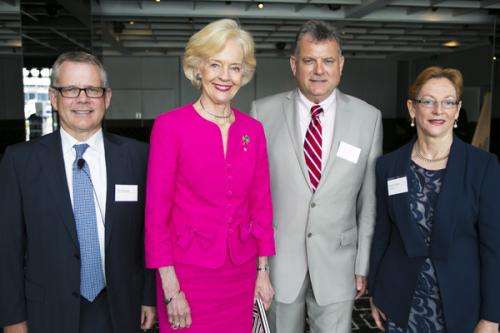Challenges still face women seeking seniority in business

Research conducted by the UTS Centre for Corporate Governance underpinning the 2012 Australian Census of Women in Leadership reveals a decade of negligible change for women in executive ranks.
The Census was launched this week by Her Excellency Ms Quentin Bryce AC CVO Governor General of the Commonwealth of Australia on behalf of the Equal Opportunity for Women in the Workplace Agency (EOWA).
The Census reveals that two thirds of ASX 500 companies have no female executives and only 12 have a female CEO. It shows Australia has the lowest percentage of female executives compared to countries with similar governance structures.
UTS Centre for Corporate Governance Director Professor Thomas Clarke said there was, however, much in the report to be encouraged by.
"Women on boards in the ASX 200 has risen from 8.4 per cent in 2010 to 12.3 per cent in 2012, and the percentage of ASX 200 companies with at least one woman on their board has risen from 46 per cent to 61.5 per cent - so the majority of ASX 200 companies now have at least one woman on board," Professor Clarke said.
"But this needs to be set in the context of the world-wide movement for increasing the representation of women on company boards that has seen seven countries adopt mandatory regulation to ensure a move towards a quota of at least 40 per cent representation of women.
"In Australia the ASX has determined on companies setting voluntary targets, and so far, this has delivered good results over the past two years. However if further progress is not made in the next few years it is possible quotas will be considered in Australia. When we turn to women in senior executive ranks, the picture is much less promising."
EOWA Director Helen Conway said the Census had been conducted annually for a decade and that she had hoped for greater progress.
"Companies have failed to develop and maintain a strong pipeline of female talent and you can see this in the negligible growth in female executive management," Ms Conway said.
"I welcome that women are finding their way onto some boards, but the number of women in senior management has increased only marginally. People are ticking the box at the board level but they're not applying the same standards to management.
"Even when it comes to boards, the number of women is still very small. Less than one in ten directorships across the ASX 500 companies are held by women. This should challenge companies to examine their gender equality record."
Ms Conway said meaningful targets must be set for achieving gender diversity and increasing the ranks of women at leadership and management levels. Managers should be also held to account – and remunerated – for delivering results against these targets, and ensure that women are not left on the sidelines.
"The new Workplace Gender Equality Act will enable the Agency to establish industry-based benchmarks which companies can use to set their own gender equality targets," Ms Conway said.
"In addition, the Act will give shareholders access to reports lodged with the Agency which investors can use to assess the gender performance of companies."
Other Census findings:
- Women are under-represented in the pipeline to senior leadership, especially in crucial line management roles. Men hold 2,148 line positions in the ASX 500; women hold 141 line positions.
- Female directors are more likely than male directors to hold multiple directorships: 23.3 per cent of female directors of ASX 500 companies hold more than one directorship, compared to 14.3 per cent of male directors.
- Pharmaceutical biotech and life sciences, consumer services, transportation, diversified financials, and retailing are the top five industries in the ASX 500 for female executive appointments (ranging from 14.1 per cent to 22.2 per cent).
- Consumer durables and apparel, utilities, capital goods, energy, and materials (dominated by mining) are the five worst performing industries in the ASX 500 for female executive appointments (ranging from zero to 6.4 per cent ).
More information: www.eowa.gov.au/
Provided by University of Technology, Sydney

















